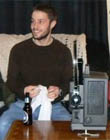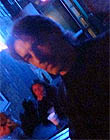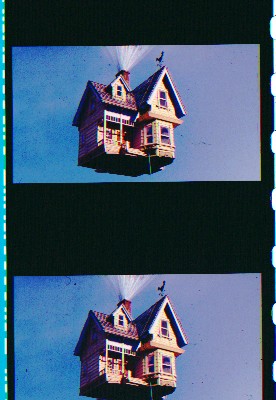|
|
This topic comprises 2 pages: 1 2
|
|
Author
|
Topic: "UP!" Image Undersized?
|
|
|
|
|
|
|
|
|
|
|
|
|
|
|
|
|
|
|
|
|
|
|
|
|
|
|
John Hawkinson
Film God

Posts: 2273
From: Cambridge, MA, USA
Registered: Feb 2002
|
 posted 07-04-2009 04:00 PM
posted 07-04-2009 04:00 PM




It's certainly hard to tell from Jim's picture.
Jim, when you say, "As you can see, the image IS slightly horizontally undersized," if you're referring to the black space between the DTS timecode and the left edge of the image, then that is not evidence of being undersized.
DTS specifies that the center of the timecode falls 0.299" from the reference edge of the film. SMPTE 195 specifies that Dimension D, the distance from the reference edge to the projectable image area, is 0.324". So typically there is 0.025" of space there, or just under 1/32" of an inch.
But with non-animation, there is the distinction between the projectable image area and the "film image area," the latter of which isn't defiend in SMPTE 195, but can be substantially larger. Typically that area extends much closer to the soundtrack, because of the camera aperture, etc.
As many have said, it seems likely that UP! is matted to exactly 0.825" wide, rather than filling the extra space with slop. Your scan isn't quite high resolution to tell with precision, but let's try anyway.
Assuming that that the horizontal and vertical are scanned at 1:1, measuring the top of the upper left perforation to the top of the next perforation down, we get 57 pixels. Since the perforation pitch is 0.187", then we conclude your scan is at 57/0.187 => 304.813 px/inch.
Measuring the width of the image across the top, I get 248 px, which comes out to 0.814". Which is just undersized from 0.825", the specification. But it would only have to be 252 px, or four more, in order to get 0.825". And because the pixel boundaries are fuzzy, I think there could well be 2 more pixels on either side. So I don't think the measurement here is instructive.
Things being what they are, I would tend to suspect that your apertures are indeed oversized, and you make use of the extra area in the camera aperture in most cases, and it's only for a film like UP! that's digitally rendered without attention to this question that you have a problem. But conceivably you might see the same effect from any Digital Intermediate film.
So run some RP40 (35PA or 35IQ) and let us know!
--jhawk
| IP: Logged
|
|
|
|
|
|
All times are Central (GMT -6:00)
|
This topic comprises 2 pages: 1 2
|
Powered by Infopop Corporation
UBB.classicTM
6.3.1.2
The Film-Tech Forums are designed for various members related to the cinema industry to express their opinions, viewpoints and testimonials on various products, services and events based upon speculation, personal knowledge and factual information through use, therefore all views represented here allow no liability upon the publishers of this web site and the owners of said views assume no liability for any ill will resulting from these postings. The posts made here are for educational as well as entertainment purposes and as such anyone viewing this portion of the website must accept these views as statements of the author of that opinion
and agrees to release the authors from any and all liability.
|

 Home
Home
 Products
Products
 Store
Store
 Forum
Forum
 Warehouse
Warehouse
 Contact Us
Contact Us




 Printer-friendly view of this topic
Printer-friendly view of this topic















